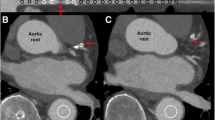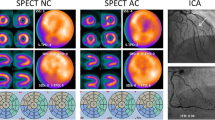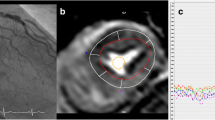Abstract
Background and purpose: Cardiovascular magnetic resonance (CMR) perfusion can accurately detect coronary artery disease (CAD). However, the absence of efficient, easy-to-use and reliable image analysis software is an obstacle to its introduction into clinical practice. The aim of this study was to evaluate new color-encoded semiautomatic software for analysis of first-pass CMR perfusion in comparison to tetrofosmin myocardial single photon emission computed tomography (SPECT), using X-ray angiography as the standard of truth for the detection of CAD. Methods: Thirty-two patients underwent both SPECT and CMR perfusion at rest and adenosine stress. Twenty of these patients also underwent X-ray angiography. Off-line CMR image analysis consisted of six steps to generate a color display of the myocardial perfusion reserve index (MPRI). The MPRI color-maps were analyzed visually and compared to SPECT. Results: In comparison to X-ray angiography overall accuracy was 87% for CMR and 77% for SPECT perfusion to detect significant CAD (stenosis ≥ 70%). In comparison with SPECT sensitivity was 80%, specificity 91%, and the overall agreement 89% for CMR. Conclusions: Post-processing of CMR perfusion data using new semiautomatic software to generate and display the MPRI visually as color-encoded images is feasible and fast. In this study it yielded higher accuracy than SPECT to detect significant CAD on X-ray angiography. Correlation between SPECT and CMR accuracy for detection of perfusion defects was high. This method may accelerate the time-consuming analysis of CMR perfusion data, thus enabling a more widespread clinical utility.
Similar content being viewed by others
References
Manning WJ, Atkinson DJ, Grossmann W, Paulin S, Edelman RR.First-pass nuclear magnetic resonance imaging studies using gadolinium-DTPA in patients with coronary artery disease.J Am Coll Cardiol 1991;18:959–965.
Wilke N, Jerosch-Herold M, Zenovich A, Stillman AE. Magnetic resonance rst pass myocardial perfusion imag-ing:clinical validation and future applications.J Magn Reson Imaging 1999;10:676–685.
Wilke N, Jerosch-Herold M, Wang Y,et al.Myocardial perfusion reserve:assessment with multisection,quantitative,rst-pass MR imaging.Radiology 1997;204:373–384.
Jerosch-Herold M, Wilke N, Stillman AE.Magnetic resonance quanti cation of the myocardial perfusion reserve with a Fermi function model for constrained devolution. MedPhys 1998;25:73–84.
Fritz-Hansen T, Rostrup E, Sondergaard L, Ring PB, Amtorp O, Larsson HB.Capillary transfer constant of Gd-DTPA in the myocardium at rest and during vasodilation assessed by MRI.Magn Reson Med 1998;40:922–929.
Wilke N, Simm C, Zhang J,et al.Contrast-enhanced rst pass myocardial perfusion imaging:correlation between myocardial blood flow in dogs at rest and during hyperemia. Magn Reson Med 1993;29:485–497.
Walsh EG, Doyle M, Lawson MA, Blackwell GG, Pohost GM.Multislice rst-pass myocardial perfusion imaging on a conventional clinical scanner.Magn Reson Med 1995;34: 39–47.
Al-Saadi N, Nagel E, Gross M,et al.Noninvasive detection of myocardial ischemia from perfusion reserve based on cardiovascular magnetic resonance.Circulation 2000;101: 1379–1383.
Al-Saadi N, Nagel E, Gross M,et al.Improvement of myocardial perfusion reserve early after coronary intervention:assessment with cardiac magnetic resonance imaging.J Am Coll Cardiol 2000;36:1557–1564.
Matheijssen NAA, Louwerenburg HW, van Rugge FP,et al.Comparison of ultrafast dipyridamole magnetic resonance imaging with dipyridamole SestaMIBI SPECT for detection of perfusion abnormalities in patients with one-vessel coronary artery disease:assessment by quantitative model tting.Magn Reson Med 1996;35:221–228.
Eichenberger AC, Schuiki E, Kochli VD, Amann FW, McKinnon GC, von Schulthess GK.Ischemic heart disease: assessment with gadolinium-enhanced ultrafast MR imaging and dipyridamole stress.J Magn Reson Imaging 1994;4: 425–431.
Schwitter J, Nanz D, Kneifel S,et al.Assessment of myocardial perfusion in coronary artery disease by magnetic resonance.A comparison with positron emission tomography and coronary angiography.Circulation 2001;103: 2230–2235.
Al-Saadi N, Gross M, Bornstedt A,et al.Comparison of different semiquantitative parameters for the assessment of a myocardial perfusion reserve index by magnetic resonance imaging.Z Kardiol 2001;90:824–834.
Nagel E, Klein C, Paetsch I,et al.Magnetic resonance perfusion measurements for the noninvasive detection of coronary artery disease.Circulation 2003;108:432–437.
Breeuwer M, Quist M, Spreeuwers L, Paetsch I, Al-Saadi N, Nagel E.Towards automatic quantitative analysis of cardiac MR perfusion images.In:Proceeding CARS,Berlin, Germany,2001;922–927.
Chia JM, Fischer SE, Wickline SA, Lorenz CH.Performance of QRS detection for cardiac magnetic resonance imaging with a novel vectorcardiographic triggering method.J Magn Reson Imaging 2000;12:678–688.
Pruessmann KP, Weiger M, Scheidegger MB, Boesiger P. SENSE:Sensitivity encoding for fast MRI.Magn Reson Med 1999;42:952–962.
Baim DS, Grossmann W.Cardiac Catherization,Angiography,and Intervention.5th edn.Philadelphia: Williams & Wilkins,1996.
Breeuwer M, Spreeuwers L, Quist M.Automatic quantita-tive analysis of cardiac MR perfusion images.In:Proceed-ings SPIE Medical Imaging,San Diego,USA,2001;733–742.
Hajnal JV, Hill DL, Hawkes DJ.Medical image registration.1st ed.Boca Raton: CRC Press,2001.
Swets JA.Measuring the accuracy of diagnostic systems. Science 1988;240:1285–1288.
Cerqueira MD, Weissmann NJ, Kaul S,et al.Standardized myocardial segmentation and nomenclature for tomographic imaging of the heart.J Cardiovasc Magn Reson 2002;4:203–210.
Thiele H, Plein S, Ridgway JP,et al.Effects of missing dynamic images on myocardial perfusion reserve index calculation:comparison between an every heartbeat and an alternate heartbeat acquisition.J Cardiovasc Magn Reson 2003;5:343–352.
Panting JR, Gatehouse PD, Yang GZ,et al.Abnormal subendocardial perfusion in cardiac syndrome X detected by cardiovascular magnetic resonance imaging.N Engl J Med 2002;346:1948–1953.
Keijer JT, van Rossum AC, van Eenige MJ,et al.Magnetic resonance imaging of regional myocardial perfusion in patients with single-vessel coronary artery disease:quantitative comparison with 201Thallium-SPECT and coronary angiography.J Magn Reson Imaging 2000;11:607–615.
Penzkofer H, Wintersperger BJ, Knez A, Weber J, Reiser M.Assessment of myocardial perfusion using multisection rst-pass MRI and color-coded parameter maps:a comparison to 99mTc sesta mibi SPECT and systolic myocardial wall thickening analysis.Magn Reson Imag 1999;17(2): 161–170.
Ibrahim T, Nekolla SG, Schreiber K,et al.Assessment of coronary flow reserve:comparison between contrast-enhanced magnetic resonance imaging and positron emission tomography.J Am Coll Cardiol 2002;39:864–870.
Gallippi CM, Kramer CM, Hu Y-L, Vido DA, Reichek N, Rogers WJ.Fully automated registration and warping of contrast-enhanced rst-pass perfusion images.J Cardiovasc Magn Reson 2002;4:459–469.
Panting JR, Gatehouse PD, Yang GZ,et al.Echo-planar magnetic resonance myocardial perfusion imaging:parametric map analysis and comparison with thallium SPECT. J Magn Reson Imaging 2001;13:192–200.
Yang GZ, Burger P, Panting J,et al.Motion and defor-mation tracking for short axis echo-planar myocardial perfusion imaging. Med Image Anal 1998;2:285–302.
Hendel RC, Corbett JR, Cullom SJ, DePuey EG, Garcia EV, Bateman TM.The value and practice of attenuation correction for myocardial perfusion SPECT imaging:a joint statement from the American Society of Nuclear Cardiology and the Society of Nuclear Medicine.J Nucl Cardiol 2002; 9:135–143.
Thorley PT, Ball J, Sheard KL, Sivananthan UM.Evaluation of 99Tcm-tetrofosmin as a myocardial perfusion agent in routine clinical use.Nucl Med Com 1995;16: 733–740.
Uren NG, Melin JA, deBruyne B, Wijns W, Baudhuin T, Camici PG.Relation between myocardial blood flow and the severity of coronary artery stenosis.N Engl J Med 1994; 330:1782–1788.
Klocke FJ.Measurements of coronary flow reserve:defining pathophysiology versus making decisions about patient care.Circulation 1987;76:1183–1189.
Meier P, Zierler KL.On the theory of the indicator-dilution method for measurement of blood flow and volume.J Appl Physiol 1954;6:731–744.
Zaret B, Wackers F.Nuclear cardiology:review article II.N Engl J Med 1993;329:855–863.
Zaret B, Wackers F.Nuclear cardiology:review article I.N Engl J Med 1993;329:775–783.
Author information
Authors and Affiliations
Rights and permissions
About this article
Cite this article
Thiele, H., Plein, S., Breeuwer, M. et al. Color-Encoded Semiautomatic Analysis of Multi-Slice First-Pass Magnetic Resonance Perfusion: Comparison to Tetrofosmin Single Photon Emission Computed Tomography Perfusion and X-Ray Angiography. Int J Cardiovasc Imaging 20, 371–384 (2004). https://doi.org/10.1023/B:CAIM.0000041938.45383.a4
Issue Date:
DOI: https://doi.org/10.1023/B:CAIM.0000041938.45383.a4




